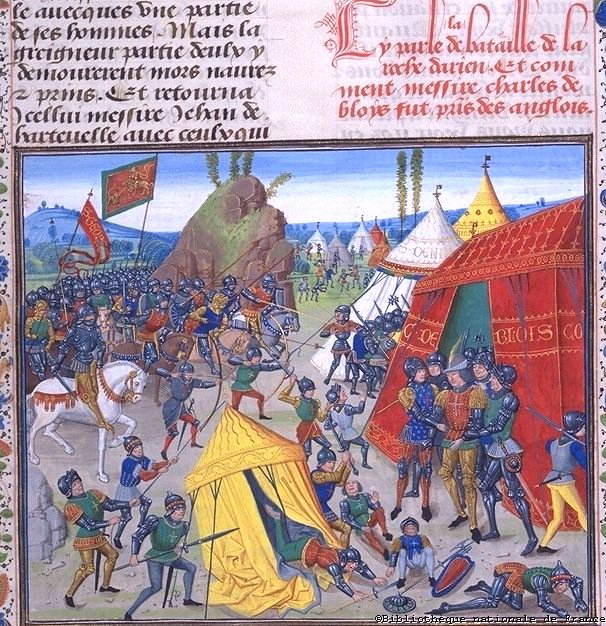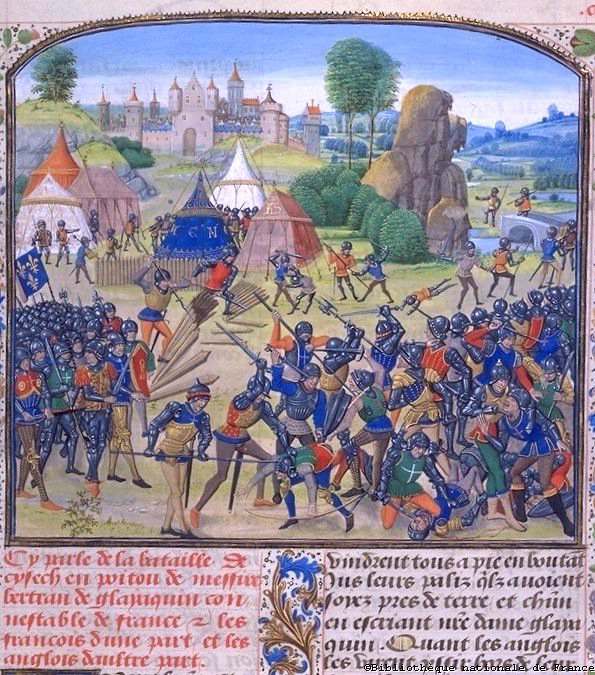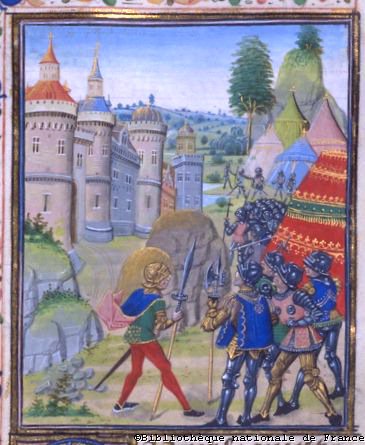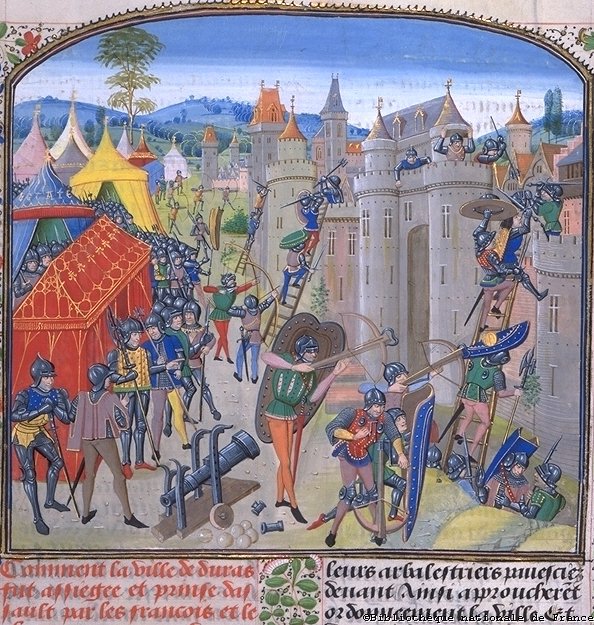| Author |
Message |
|
Anders Nilsson
|
 Posted: Fri 30 May, 2008 7:23 am Post subject: Battlefield weapons Posted: Fri 30 May, 2008 7:23 am Post subject: Battlefield weapons |
 |
|
Hello
I often get the question.
"Did they really use those kind of weapons on the battlefield."
For singlehanded sword, axes, halberd and spears I know the answer.
But for the longsword and the poleaxe I dont know.
What do you say.
What kind of weapons was used on the battlefield and was poleaxes and longswords used?
To keep this in a discussable form, please answer with years also since weapons changed overtime.
Lets start at 500 and disuss weapon evolution up till ca 1500.
|
|
   |
 |
|
Justin King
Industry Professional
|
 Posted: Fri 30 May, 2008 7:53 am Post subject: Posted: Fri 30 May, 2008 7:53 am Post subject: |
 |
|
My answer is very general and probably not really what you are looking for, but I think it is safe to assume that both of these types of weapons were most certainly used in battle at one point or another (just about every type of deadly instument you can think of has been, truth be told) , whether they were common or "mainstream" battlefield weapons is perhaps another story and as you indicated would vary from time period to time period.
The longsword is easier to find examples of, depending on how you are defining "longsword" , you may have to look no farther than the Scottish 2-handed claymore or some of the Landesknecht swords (precisely speaking these are two handers but if they were used in battle alongside single-handed swords we can safely guess that in-between sized swords were used as well).
The poleaxe is somewhat harder to find battlefield examples of but I would be shocked to learn that it was never employed besides in duels or as a guard-type weapon. If farmers carried pitchforks, clubs and other makeshift weapons to battle it would seem odd if the poleaxe were overlooked by those to whom they were availible.
Last edited by Justin King on Mon 02 Jun, 2008 9:52 pm; edited 1 time in total
|
|
  |
 |
Sean Flynt

|
 Posted: Fri 30 May, 2008 8:08 am Post subject: Posted: Fri 30 May, 2008 8:08 am Post subject: |
 |
|
There's another thread here covering the poleaxe, but the short answer is, "yes." Contemporary artwork shows that both poleaxes and hand-and-a-half swords/bastard swords/longswords were very common. Images of the last half of the 15th c. are especially clear on this point. In particular, see illuminations for Froissart's Chronicles ca. 1480. There are at least five poleaxes visible in the last image below. The vast majority of swords shown in these and other illuminations for this edition are long-gripped hand-and-a-half Type XVIII or Type XV weapons. Note the longsword and buckler worn by the figure at right in the first image below.
 Attachment: 148 KB Attachment: 148 KB

 Attachment: 139.31 KB Attachment: 139.31 KB

 Attachment: 45.04 KB Attachment: 45.04 KB

 Attachment: 142.38 KB Attachment: 142.38 KB

-Sean
Author of the Little Hammer novel
https://www.amazon.com/Little-Hammer-Sean-Flynt/dp/B08XN7HZ82/ref=sr_1_1?dchild=1&keywords=little+hammer+book&qid=1627482034&sr=8-1
|
|
   |
 |
Sean Flynt

|
 Posted: Fri 30 May, 2008 8:26 am Post subject: Posted: Fri 30 May, 2008 8:26 am Post subject: |
 |
|
Keep in mind that poleaxes developed from the long-hafted axes of the sort seen in the Bayeaux embroidery and certainly used much earlier. They didn't just pop up on the battlefield, fully developed, in the 15th c. They were there all along, slowly changing. Probably the latest field use of the poleaxe was in Ireland, where the 6' tall, single-edged Gallowglass axe persisted through the 16th c. The point is, what we call a poleaxe is not substantially different from any other long-hafted "battle axe". Our term simply denotes the addition of various spikes and variations of head designs.
-Sean
Author of the Little Hammer novel
https://www.amazon.com/Little-Hammer-Sean-Flynt/dp/B08XN7HZ82/ref=sr_1_1?dchild=1&keywords=little+hammer+book&qid=1627482034&sr=8-1
|
|
   |
 |
|
Doug Lester
Location: Decatur, IL Joined: 12 Dec 2007
Posts: 167
|
 Posted: Fri 30 May, 2008 8:39 am Post subject: Posted: Fri 30 May, 2008 8:39 am Post subject: |
 |
|
I can't help you out on the pole ax but on the two handed sword I have two pictures in the book "The Art of Renaissance Warfare" by Stephen Turnbull. On page 162 there is a picture representing that death of Bayard which shows a man leaning on a two handed sword that is as least as long as he is tall. On page 182 there is a picture of John Frederic, Elector of Saxony with a two handed sword on his shoulder. It should be noted in the later picture that he also is armed with a "regular" sword on a dagger. I think that that would support the notion that these very long swords were special application weapons.
I am aware that there is a danger in assuming that the weapons in a picture of a battle scene are contemporary with the battle because that they could only be contemporary with the artist who is illustration weapons from his time but it does show that those weapons were carried and used at some time. A little more accurate would be someone, such as John Frederic, posing with a weapon. I think that it would be pretty safe to assume that the weapon was contemporary with that person, and that if the person was in war garb, that they were also battlefield weapons as opposed to civilian carry of tournament weapons.
The same book does have a picture in the color plates of Henry VIII's armour set up with what would fall into the group of weapons known as pole axes. This might or might not support the use of that weapon on the battlefield.
|
|
  |
 |
|
Anders Nilsson
|
 Posted: Fri 30 May, 2008 9:39 am Post subject: Posted: Fri 30 May, 2008 9:39 am Post subject: |
 |
|
Thanks for your answers.
I have always thought that they where used, but I was not sure.
Then the next question is, how where they used on the field.
My guess is as secondary weapons. I wouldn´t like to do a Zwerchau in a formation...
|
|
   |
 |
Sean Flynt

|
 Posted: Fri 30 May, 2008 9:54 am Post subject: Posted: Fri 30 May, 2008 9:54 am Post subject: |
 |
|
| Anders Nilsson wrote: | Thanks for your answers.
I have always thought that they where used, but I was not sure.
Then the next question is, how where they used on the field.
My guess is as secondary weapons. I wouldn´t like to do a Zwerchau in a formation... |
Poleaxes were primary weapons, swords could be either primary or secondary. Notice in the last image above that one man is climbing a ladder armed with a poleaxe and shield, and the wall's defenders also are using poleaxes. One of the images above shows a man-at-arms with a poleaxe and no sword.
The images above, among others, show how they were used. There are many depictions of these weapons being used in close-packed groups (as on shipboard). Note that the Froissart swords, despite very long grips in some cases, tend to have short-ish blades. Also, most are shown in single-hand use. I think it's very interesting that so many illustrations show the off hand used to control an opponent for finishing off with the swordhand. See examples above.
However well a man might be formally trained in longsword use, the school bears little resemblance to the field. One would head into battle with good reflexes, good theory, good technique and the understanding that circumstances may prevent the free exercise thereof. But your enemy would be in the same bind, so your training would still be an advantage. Judicial duels would be very different and probably much more like the school.
I have no doubt that men were injured or killed by their allies in the chaos of the field. Strikes missed or were deflected, people stumbled, people swung blindly, etc. That may help account for the standardization of short swords like the Katzbalger for infantry.
-Sean
Author of the Little Hammer novel
https://www.amazon.com/Little-Hammer-Sean-Flynt/dp/B08XN7HZ82/ref=sr_1_1?dchild=1&keywords=little+hammer+book&qid=1627482034&sr=8-1
|
|
   |
 |
|
Joel Minturn
|
 Posted: Mon 02 Jun, 2008 9:51 pm Post subject: Posted: Mon 02 Jun, 2008 9:51 pm Post subject: |
 |
|
|
Wasn't the Katzbalger a backup weapon used for when the fighting got in close? not a primary weapon. But I agree friends could get hurt so that would another good reason to stay in formation. you know behind the friendly swinging blades.
|
|
  |
 |
Luka Borscak

|
 Posted: Tue 03 Jun, 2008 2:14 am Post subject: Posted: Tue 03 Jun, 2008 2:14 am Post subject: |
 |
|
|
Yes, it was a backup for a pike. You don't swing pike so you won't kill your friend with it. But when pikes break or something, you need a shortsword. Somebody might take a longsword and he would be dangerous to his own men, that's why they probably had to have same length shortswords.
|
|
  |
 |
|
|

